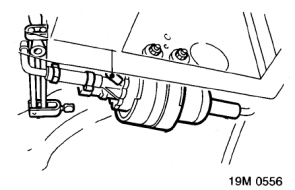43
Noisy
fuel pump
Roger Parker, who has close contact with an RV8 and runs
an MGBV8 EFi Roadster conversion (Green 4092), provides this useful article. (Nov
90)
Since
the fuel pump has a well documented history from its use in other cars, some of
the known faults that can occur can be simply diagnosed. One common problem has
been with a noisy fuel pump. This is usually down to the inherent characteristic
of these pumps of not being able to draw fuel well. Once they have an unrestricted
supply and delivery route, the pumps will happily deliver up to 4.1bar (60psi)
when operated at normal system voltage, nominally 13.5 volts. When the supply
is restricted, especially in the tank to pump feed, the pumps become very noisy
and can resemble the sound of a Black and Decker drill. Very hot conditions can
also induce this noise.
The common cause for restriction in the fuel lines
is within the filters. As the accumulation of debris from the petrol storage tank
is a common difficulty and in severe cases can very quickly block up a filter.
Replacement of the pre-pump filter is the first step, followed by the feed line
from pump to fuel rail. If subsequently excess noise returns and it is found the
filter is silting again, it will require the removal of the fuel tank and a comprehensive
clean out.
Examination of the fuel pump will reveal that the inlet has
a 12mm bore size, whilst the delivery side uses the common 6mm bore size. The
choice of the different sizes reflects the acknowledged weaknesses of these pumps
to draw fuel and it comes as a surprise to see that the RV8 uses a stepped hose
to downsize the feed pipe from the tank to pump from 12mm to 6mm. This is without
doubt to allow the original pattern of fuel tank sender unit fitted which includes
the fuel feed pipe to the later MGB models to be used with the RV8.
From
personal experience with these EFi systems in MGBV8 conversions long before the
launch of the RV8, I know that the system overcomes the potential deficiency because
the positioning of the fuel pump at such a low position relative to the fuel tank.
This provides the assistance of gravity to compensate. However this will make
fuel filter changing more important.
| 
Source: RV8 Repair Manual
AKM7153ENG Fuel System, Repairs, page 9.
The regulated working pressure
of the fuel system is 2.5 bar above internal manifold pressure. That means that
measured externally the fuel pressure will be regulated to between 1.8 and 2.5
bar depending on engine load and throttle position. Since the pump operates at
4.1 bar when supplied with normal system voltage levels there is a significant
excess margin of pump performance.
All
V8 Rover Vitesse and 2.0 litre injected Maestro and Montego models operate with
an inline fuel pump resistor to cut down the voltage supplied to the pump in much
the same way as a ballasted coil system operates. This was used to reduce the
speed and consequent noise of the fuel pump. The fuel pump resistor is a standard
Rover part DRC 3017 and I have incorporated this into several injected V8 conversions
I have built. For those RV8 owners who consider that their pumps are intrusive
and that other solutions have not worked, then this offers a way of achieving
some improvement.
The resistor is wired into the electrical supply to the
pump to provide a mirror image of standard Rover systems. To achieve this an additional
wire is taken from the starter motor to the pump side of the resistor so that
when the engine is being cranked, a full 12 plus volt supply is delivered to the
pump. This ensures that if the battery is low or the starter motor is drawing
a higher current, then as much power as possible is fed to the pump to provide
fuel supply. Once the engine is running and the cranking disengaged, the direct
supply is also disengaged and the power supply is only via the resistor. One other
advantage of introducing the resistor into the system is that the reduced rotational
speed of the pump leads to a longer life. |



